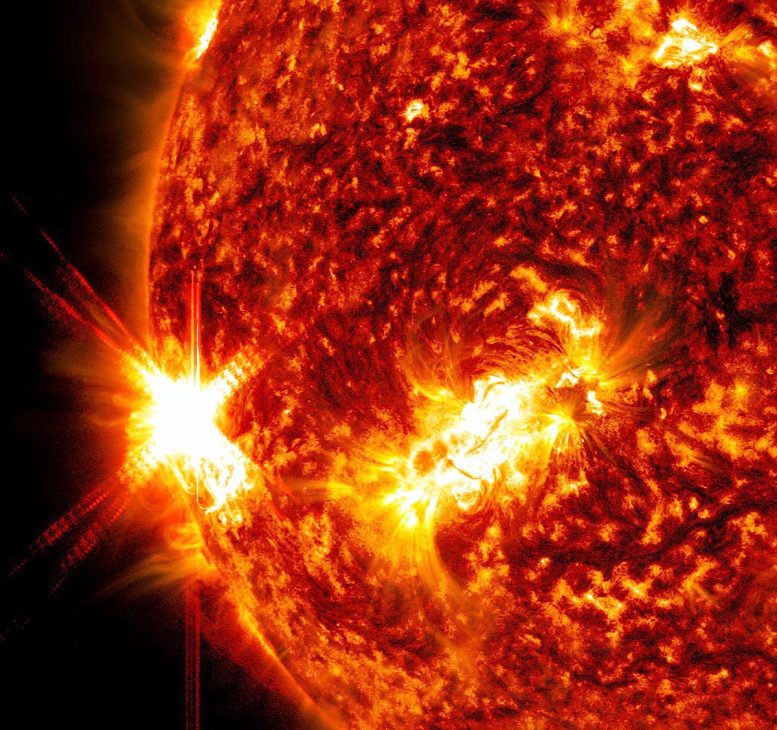The Sun emitted a strong solar flare, peaking at 1:50 p.m. EST on January 9, 2023. Imagery of the event was captured by NASA’s Solar Dynamics Observatory, which constantly watches the Sun.
Solar flares are intense explosions of energy that can disrupt radio communications, damage power grids, and affect navigation signals. They also pose a threat to spacecraft and astronauts.
An X1.9 class solar flare flashes on the left edge of the Sun on January 9, 2023. This video was captured by NASA’s Solar Dynamics Observatory and shows a blend of light from the 171, 131 and 304 angstrom wavelengths. Credit: NASA/GSFC/SDO
This flare is classified as an X1.9 flare. It is categorized as an X-class flare, which is the most powerful class of solar flares. The number following the “X” indicates the relative strength of the flare, with larger numbers indicating stronger flares. An X1.9 flare is therefore a relatively strong flare, but less intense than an X2.0 or higher. These flares can cause disruptions to radio communications and power grids on Earth, and can also be potentially dangerous for spacecraft and astronauts.
-

- An X1.9 class solar flare flashes on the left of the Sun on January 9, 2023. This image was captured by NASA’s Solar Dynamics Observatory at 1:57 EST and shows light in the 193 angstrom wavelength. Credit: NASA/SDO
-

- An X1.9 class solar flare flashes on the left edge of the Sun on January 9, 2023. This image was captured by NASA’s Solar Dynamics Observatory and shows a blend of light from the 171 and 131 angstrom wavelengths. Credit: NASA/GSFC/SDO
-

- An X1.9 class solar flare flashes on the left of the Sun on January 9, 2023. This image was captured by NASA’s Solar Dynamics Observatory at 1:55 EST and shows light in the 131 angstrom wavelength. Credit: NASA/SDO
For more details on how such space weather may affect Earth, please visit NOAA’s Space Weather Prediction Center, the U.S. government’s official source for space weather forecasts, watches, warnings, and alerts. NASA works as a research arm of the nation’s space weather effort. NASA observes the Sun and our space environment constantly with a fleet of spacecraft that study everything from the Sun’s activity to the solar atmosphere, and to the particles and magnetic fields in the space surrounding Earth.
-

- An X1.9 class solar flare flashes on the left of the Sun on January 9, 2023. This image was captured by NASA’s Solar Dynamics Observatory at 1:49 EST and shows light in the 171 angstrom wavelength. Credit: NASA/SDO
-

- An X1.9 class solar flare flashes on the left of the Sun on January 9, 2023. This image was captured by NASA’s Solar Dynamics Observatory at 1:49 EST and shows light in the 304 angstrom wavelength. Credit: NASA/SDO
-

- An X1.9 class solar flare flashes on the left of the Sun on January 9, 2023. This image was captured by NASA’s Solar Dynamics Observatory at 1:49 EST and shows light in the 131 angstrom wavelength. Credit: NASA/SDO
The Solar Dynamics Observatory (SDO) is a NASA mission that was launched in 2010 to study the sun and its effects on Earth. The spacecraft is equipped with a suite of instruments that allow it to observe the sun’s magnetic field, track the movement of material on the sun’s surface, and measure the sun’s output of various forms of radiation. The data collected by the SDO is used to improve our understanding of the sun’s inner workings, as well as its impact on Earth’s climate and environment. The SDO has helped to improve our ability to predict solar flares and other space weather events, which can have significant effects on satellite and ground-based technology.






Recommended Comments
There are no comments to display.
Join the conversation
You can post now and register later. If you have an account, sign in now to post with your account.
Note: Your post will require moderator approval before it will be visible.